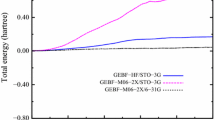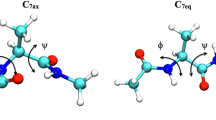Abstract
The structure of 7-azaindole dimer (7AI2) as a model compound for DNA base pair has been studied by classical molecular dynamics (MD) and path integral molecular dynamics (PIMD) simulations on the semi-empirical PM6 potential energy surface at various temperatures, to investigate the nuclear quantum effect and temperature dependency on the hydrogen-bonded moiety of 7AI2. At 75 K, two H-bondings are maintained throughout a given simulation time in both classical and PIMD (quantum) simulations. At 150 K, these two H-bondings are maintained in only quantum simulation, while in classical simulation, the two H-bondings (or one H-bonding) are sometimes broken and reformed. For 225 K, these two H-bondings are broken in both classical and quantum simulations. We have also applied a principal component analysis to MD and PIMD simulations to analyze the intermolecular motions. We found that the ratio of the second lowest (dimer butterfly out-of-plane) vibrational mode from normal mode analysis which is the most dominant motion decreases with increasing temperature, whereas that of first lowest (dimer torsion out-of-plane) vibrational mode which is the second most dominant motion increases with increasing temperature from temperature 75 to 150 K and then decreases at 225 K due to the nuclear quantum effect. Moreover, the motions of two hydrogen-bonded structures are significantly different with increasing temperature. This difference is revealed by the principal component analysis which shows that the ratio of opening in-plane motion decreases and the ratio of stretching in-plane motion decreases.






Similar content being viewed by others
References
Jeffrey GA, Saenger W (1991) Hydrogen bonding in biological structures. Springer, New York
Goodman MF (1995) DNA models: mutations caught in the act. Nature 378(6554):237–238
Al-Taylor C, Ashraf el-Bayoumi M, Kasha M (1969) Excited-state two-proton tautomerism in hydrogen-bonded n-heterocyclic base pairs. Proc Natl Acad Sci 63(2):253–260
Catalan J, Kasha M (2000) Photophysics of 7-azaindole, tts doubly-H-bonded base-pair, and corresponding proton-transfer-tautomer dimeric species, via defining experimental and theoretical results. J Phys Chem A 104(46):10812–10820
Douhal A, Kim SK, Zewail AH (1995) Femtosecond molecular-dynamics of tautomerization in model base-pairs. Nature 378(6554):260–263
Sekiya H, Sakota K (2008) Excited-state double-proton transfer in a model DNA base pair: resolution for stepwise and concerted mechanism controversy in the 7-azaindole dimer revealed by frequency- and time-resolved spectroscopy. J Photochem Photobiol C Photochem Rev 9(2):81–91
Kwon OH, Zewail AH (2007) Double proton transfer dynamics of model DNA base pairs in the condensed phase. Proc Natl Acad Sci USA 104(21):8703–8708
Takeuchi S, Tahara T (2001) Excitation-wavelength dependence of the femtosecond fluorescence dynamics of 7-azaindole dimer: further evidence for the concerted double proton transfer in solution. Chem Phys Lett 347(1–3):108–114
Takeuchi S, Tahara T (2007) The answer to concerted versus step-wise controversy for the double proton transfer mechanism of 7-azaindole dimer in solution. Proc Natl Acad Sci USA 104(13):5285–5290
Suzuki T, Okuyama U, Ichimura T (1997) Double proton transfer reaction of 7-azaindole dimer and complexes studied by time-resolved thermal lensing technique. J Phys Chem A 101(38):7047–7052
Tokumura K, Watanabe Y, Itoh M (1984) A transient absorption and two-step laser excitation fluorescence study of the double proton transfer of 7-azaindole H-bonded dimers in 3-methylpentane. Chem Phys Lett 111(45):379–382
Tokumura K, Watanabe Y, Itoh M (1986) Deuterium isotope effects of excited-state and ground-state double-proton-transfer processes of the 7-azaindole H-bonded dimer in 3-methylpentane. J Phys Chem 90(11):2362–2366
Tokumura K, Watanabe Y, Udagawa M, Itoh M (1987) Photochemistry of transient tautomer of 7-azaindole hydrogen-bonded dimer studied by two-step laser excitation fluorescence measurements. J Am Chem Soc 109(5):1346–1350
Yokoyama H, Watanabe H, Omi T, Ishiuchi S-I, Fujii M (2001) Structure of hydrogen-bonded clusters of 7-azaindole studied by IR dip spectroscopy and ab initio molecular orbital calculation. J Phys Chem A 105(41):9366–9374
Hazra MK, Mukherjee M, Ramanathan V, Chakraborty T (2012) Structure and intermolecular vibrations of 7-azaindole-water 2:1 complex in a supersonic jet expansion: laser-induced fluorescence spectroscopy and quantum chemistry calculation. J Chem Sci 124(1):131–139
Catalan J, Perez P, del Valle JC, de Paz JLG, Kasha M (2002) The concerted mechanism of photo-induced biprotonic transfer in 7-azaindole dimers: a model for the secondary evolution of the classic C2h dimer and comparison of four mechanisms. Proc Natl Acad Sci 99(9):5799–5803
Dreyer J (2007) Unraveling the structure of hydrogen bond stretching mode infrared absorption bands: an anharmonic density functional theory study on 7-azaindole dimers. J Chem Phys 127(5):054309
Dwyer JR, Dreyer J, Nibbering ETJ, Elsaesser T (2006) Ultrafast dynamics of vibrational N–H stretching excitations in the 7-azaindole dimer. Chem Phys Lett 432(13):146–151
Ishikawa H, Yabuguchi H, Yamada Y, Fujihara A, Fuke K (2010) Infrared spectroscopy of jet-cooled tautomeric dimer of 7-azaindole: a model system for the ground-state double proton transfer reaction. J Phys Chem A 114(9):3199–3206
Ishikawa H, Nakano T, Takashima T, Yabuguchi H, Fuke K (2013) Deuteration effect on the NH/ND stretch band of the jet-cooled 7-azaindole and its tautomeric dimers: relation between the vibrational relaxation and the ground-state double proton-transfer reaction. Chem Phys 419:101–106
Brauer B, Gerber RB, Kabelac M, Hobza P, Bakker JM, Abo Riziq AG, de Vries MS (2005) Vibrational spectroscopy of the G-C base pair:‰ experiment, harmonic and anharmonic calculations, and the nature of the anharmonic couplings. J Phys Chem A 109(31):6974–6984
Ishibashi H, Hayashi A, Shiga M, Tachikawa M (2008) Geometric isotope effect on the N2H7+ cation and N2H5− anion by ab initio path integral molecular dynamics simulation. ChemPhysChem 9(3):383–387
Yagi K, Karasawa H, Hirata S, Hirao K (2009) First-principles quantum calculations on the infrared spectrum and vibrational dynamics of the guanine–cytosine base pair. ChemPhysChem 10(9–10):1442–1444
Pérez A, Tuckerman ME, Hjalmarson HP, von Lilienfeld OA (2010) Enol tautomers of Watson–Crick base pair models are metastable because of nuclear quantum effects. J Am Chem Soc 132(33):11510–11515. doi:10.1021/ja102004b
Daido M, Kawashima Y, Tachikawa M (2013) Nuclear quantum effect and temperature dependency on the hydrogen-bonded structure of base pairs. J Comput Chem 34(28):2403–2411
Daido M, Koizumi A, Shiga M, Tachikawa M (2011) Nuclear quantum effect on the hydrogen-bonded structure of guanine–cytosine pair. Theor Chem Acc 130(2–3):385–391
Stewart JJP (2007) Optimization of parameters for semiempirical methods V: modification of NDDO approximations and application to 70 elements. J Mol Model 13(12):1173–1213
MOPAC2009 (2008) James J. P. Stewart, Stewart computational chemistry. Colorado Spring, CO, USA. http://OpenMOPAC.net
Ahlrichs R, Baer M, Haeser M, Horn H, Koelmel C (1989) Electronic structure calculations on workstation computers: the program system turbomole. Chem Phys Lett 162(3):165–169
Frisch MJ, Trucks GW, Schelegel HB et al (2003) GAUSSIAN 03, Revision B. 05. Gaussian Inc., Pittsburgh, PA
Martyna GJ, Klein ML, Tuckerman M (1992) Nosé–Hoover chains: the canonical ensemble via continuous dynamics. J Chem Phys 97(4):2635–2643
Kawashima Y, Tachikawa M (2014) Ab initio path integral molecular dynamics study of the nuclear quantum effect on out-of-plane ring deformation of hydrogen maleate anion. J Chem Theory Comput 10(1):153–163
Marx D, Parrinello M (1994) Ab initio path-integral molecular dynamics. Z Phys B Condens Matter 95 (Copyright (C) 2014 American Chemical Society (ACS). All Rights Reserved.):143–144
Marx D, Parrinello M (1996) Ab initio path integral molecular dynamics: basic ideas. J Chem Phys 104(11):4077–4082
Cao J, Martyna GJ (1996) Adiabatic path integral molecular dynamics methods. II. Algorithms. J Chem Phys 104(5):2028–2035
Suzuki K, Tachikawa M, Shiga M (2010) Efficient ab initio path integral hybrid Monte Carlo based on the fourth-order Trotter expansion: application to fluoride ion-water cluster. J Chem Phys 132(14):144108
Cao J, Berne BJ (1993) A Born–Oppenheimer approximation for path integrals with an application to electron solvation in polarizable fluids. J Chem Phys 99(4):2902–2916
Tuckerman ME, Marx D, Klein ML, Parrinello M (1996) Efficient and general algorithms for path integral Car–Parrinello molecular dynamics. J Chem Phys 104(14):5579–5588
Shiga M, Tachikawa M, Miura S (2001) A unified scheme for ab initio molecular orbital theory and path integral molecular dynamics. J Chem Phys 115(20):9149–9159
Kawashima Y, Tachikawa M (2013) Nuclear quantum effect on intramolecular hydrogen bond of hydrogen maleate anion: an ab initio path integral molecular dynamics study. Chem Phys Lett 571:23–27
Yu XF, Yamazaki S, Taketsugu T (2011) Concerted or stepwise mechanism? CASPT2 and LC-TDDFT study of the excited-state double proton transfer in the 7-azaindole dimer. J Chem Theory Comput 7(4):1006–1015
Tachikawa M, Shiga M (2005) Geometrical H/D isotope effect on hydrogen bonds in charged water clusters. J Am Chem Soc 127(34):11908–11909
Suzuki K, Shiga M, Tachikawa M (2008) Temperature and isotope effects on water cluster ions with path integral molecular dynamics based on the fourth order Trotter expansion. J Chem Phys 129(14):144310
Koizumi A, Suzuki K, Shiga M, Tachikawa M (2011) Communication: a concerted mechanism between proton transfer of Zundel anion and displacement of counter cation. J Chem Phys 134(3):031101
Folmer DE, Poth L, Wisniewski ES, Castleman AW Jr (1998) Arresting intermediate states in a chemical reaction on a femtosecond time scale: proton transfer in model base pairs. Chem Phys Lett 287(12):1–7
Folmer DE, Wisniewski ES, Hurley SM, Castleman AW (1999) Femtosecond cluster studies of the solvated 7-azaindole excited state double-proton transfer. Proc Natl Acad Sci USA 96(23):12980–12986
Kitao A, Hirata F, Gō N (1991) The effects of solvent on the conformation and the collective motions of protein: normal mode analysis and molecular dynamics simulations of melittin in water and in vacuum. Chem Phys 158(2–3):447–472
Kawashima Y, Sugita Y, Yoda T, Okamoto Y (2005) Effects of the fixed end in single-molecule imaging techniques: a replica-exchange molecular dynamics simulation study. Chem Phys Lett 414(4–6):449–455
Kitao A, Go N (1999) Investigating protein dynamics in collective coordinate space. Curr Opin Struct Biol 9(2):164–169
Potoyan DA, Papoian GA (2011) Energy landscape analyses of disordered histone tails reveal special organization of their conformational dynamics. J Am Chem Soc 133(19):7405–7415
Yang L-W, Eyal E, Bahar I, Kitao A (2009) Principal component analysis of native ensembles of biomolecular structures (PCA_NEST): insights into functional dynamics. Bioinformatics 25(5):606–614
Acknowledgments
The present study has been supported by Grant-in-aid for Scientific Research by Ministry of Education, Culture, Spots, Science and Technology, Japan. N. Kungwan wishes to thank the Thailand Research Fund (TRG5680098) for financial support. Department of Chemistry, Faculty of Science, Chiang Mai University, Chiang Mai, Thailand is also acknowledged.
Author information
Authors and Affiliations
Corresponding authors
Electronic supplementary material
Below is the link to the electronic supplementary material.
Rights and permissions
About this article
Cite this article
Kungwan, N., Ogata, Y., Hannongbua, S. et al. Nuclear quantum effect and temperature dependency on the hydrogen-bonded structure of 7-azaindole dimer. Theor Chem Acc 133, 1553 (2014). https://doi.org/10.1007/s00214-014-1553-y
Received:
Accepted:
Published:
DOI: https://doi.org/10.1007/s00214-014-1553-y




